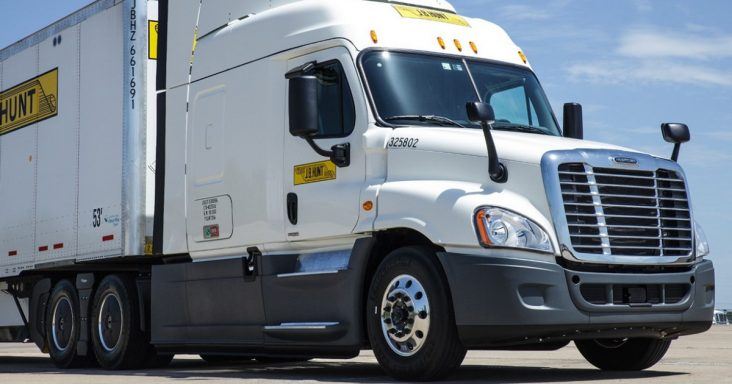J.B. Hunt earnings to fall, revenue to rise in fourth quarter
by January 7, 2020 1:08 pm 1,933 views

Lowell-based carrier J.B. Hunt Transport Services Inc. is expected to report declines in earnings per share for the fourth quarter and for 2019 as weakness continues in the brokerage segment and margins miss expectations in the intermodal segment, analysts said.
Before the markets open Jan. 17, the carrier will announce earnings for the period and for the year. Fourth-quarter earnings are expected to fall 24 cents to $1.54 per share, from $1.78 per share in the same period in 2018, based on a consensus of 20 analysts. For 2019, earnings are projected to decline 30 cents to $5.39 per share, from $5.69 per share in 2018.
Fourth-quarter revenue is expected to rise 6.3% to $2.46 billion, from $2.32 billion in the same period in 2018, according to a consensus of 15 analysts. For 2019, revenue is projected to increase by 6.5% to $9.17 billion, from $8.61 billion.
In an earnings preview, analysts Justin Long and Jack Atkins, senior associate Brian Colley and associate George Sellers, all of Little Rock-based Stephens Inc., said weakness continues in the carrier’s brokerage segment as a result of a competitive market and technology investments, and margins in the intermodal segment might be lower than expected. The analysts are encouraged by the carrier’s intermodal and dedicated segments, which have been generating nearly all of the carrier’s operating income. And, the carrier’s technology platform J.B. Hunt 360 is expected to impact profitability in the near-term but lead to gains over the long-term. J.B. Hunt 360 is a freight matching technology that uses artificial intelligence to match capacity with freight, and carriers and shippers can access the platform via a smartphone app.
Shelley Simpson, chief commercial officer and president of Highway Services for J.B. Hunt, recently spoke about technology in transportation in an interview with The Journal of Commerce and explained the increased use of smartphones has led to changes in technology with regard to transportation. She expects several changes over the next 10 years, including access to information, transparency and visibility.
“We need a more efficient way to move goods,” Simpson said in the interview. “We need to have direct visibility to how goods are moving, and so that level of data that we can think through really transforms the way we look at this business in total.”
J.B. Hunt 360 was launched in 2014 and was built upon as part of J.B. Hunt’s $500 million investment into technology improvements that it announced in 2017. In December, J.B. Hunt announced the integration of J.B. Hunt 360 with the technology platform of JDA Software Inc. of Scottsdale, Ariz. The integration is expected to provide customers with greater pricing visibility and access to available capacity. In the interview, Simpson noted that pricing will be transparent over the long-term. In 2018, J.B. Hunt started to work with project44 to integrate its visibility platform with J.B. Hunt 360.
The carrier’s brokerage segment, or Integrated Capacity Solutions, is likely to face greater headwinds in the fourth quarter as a result of competition and technology investments over the near-term, according to Long, Atkins, Colley and Sellers. Fourth-quarter margins are expected to fall 50 basis points from the third quarter of 2019. The operating loss in the segment is projected to worsen to $6.8 million, up from a loss of $5.6 million in the third quarter of 2019. Similar losses are expected in 2020 as the carrier continues to invest in technology. Over the next year, investors might focus on the segment’s revenue growth to gauge its success.
The intermodal segment, which accounted for 63% of the carrier’s overall income and 52% of its overall revenue in the third quarter, looks to have “experienced a pick-up during bid season (unlike many other transportation companies) that was aided by the re-capturing of market share during the 2019 bid season,” said Long, Atkins, Colley and Sellers. “As a result, we think intermodal volumes have been relatively in line with management’s expectation for growth of ‘a couple percent’ (year-over-year) in (the fourth quarter of 2019).”
However, rising costs related to moving empty intermodal containers from the East to the West might contribute to a flat operating ratio in the fourth quarter, from the third quarter, according to Long, Atkins, Colley and Sellers. In the carrier’s third-quarter earnings call, J.B. Hunt executives expected operating ratio to improve. Operating ratio is a company’s operating expenses as a percentage of revenue.
Over the next year, intermodal volumes are expected to rise, according to Long, Atkins, Colley and Sellers. They expect volumes to rise by about 8% in the first quarter of 2020, from the same period in 2019. For 2020, volume growth is expected to increase by 6%, from 2019. Revenue per load is projected to be flat, with price declines of between 1% and 2% being offset by a positive mix. Intermodal margins are expected to improve 40 basis points in 2020, from 2019. Overall, operating income in the segment is projected to increase by 10% in 2020, from 2019.
J.B. Hunt’s dedicated segment, or Dedicated Contract Services, added 100 trucks in the fourth quarter, while operating ratio worsened 20 basis points to 89%, from the third quarter, according to Long, Atkins, Colley and Sellers. They expect the segment to grow in 2020 and add 700 trucks over the year. Operating margins are expected to range between 11% and 13%. Private fleet conversions are expected to support “another year of double-digit operating income growth in 2020,” Long, Atkins, Colley and Sellers said.
They gave J.B. Hunt’s stock a rating of overweight, or buy, and increased its 12-month target price by $9 to $133.
Shares of J.B. Hunt (NASDAQ: JBHT) were trading Tuesday (Jan. 7) at $116.92, up $1.92, or 1.6%. In the past 52 weeks, the stock has ranged between $122.29 and $83.64.
